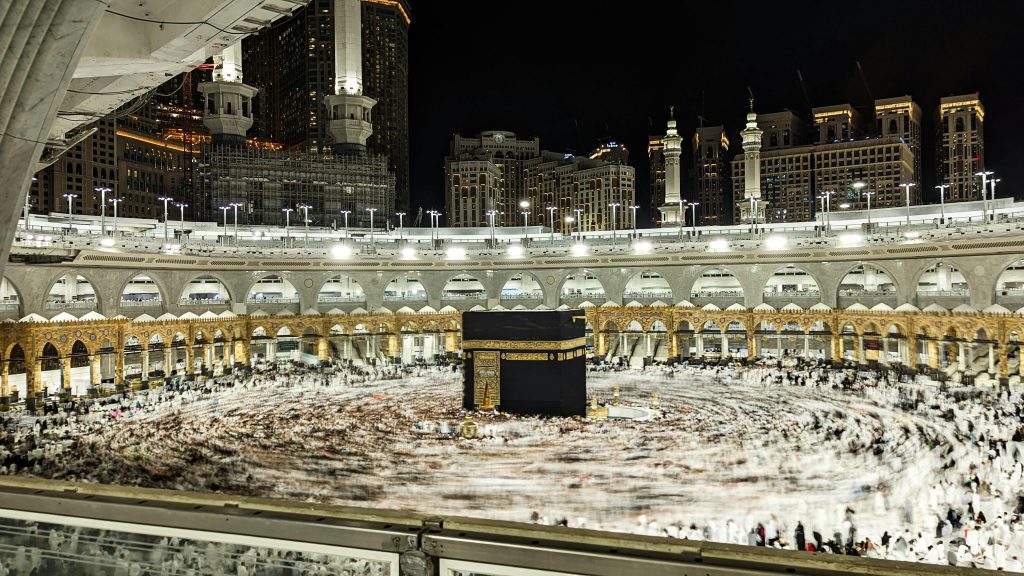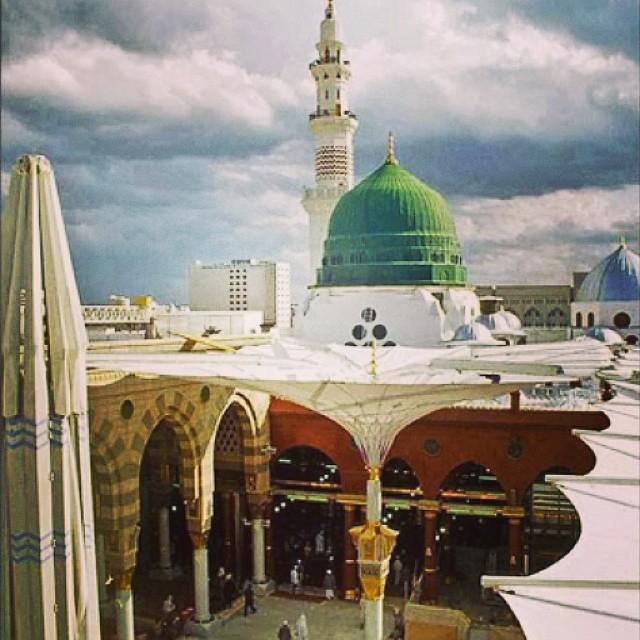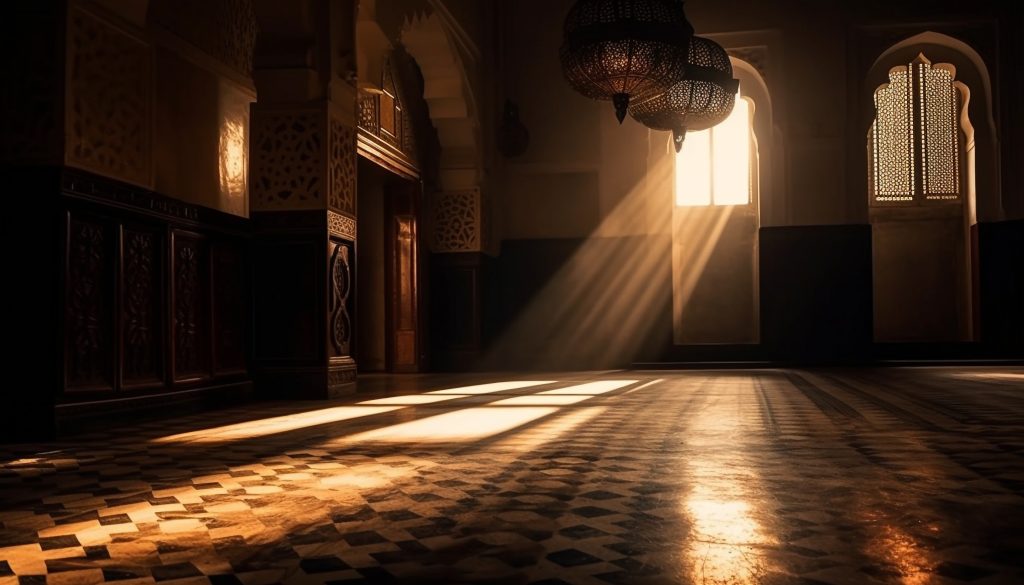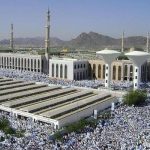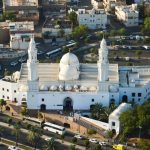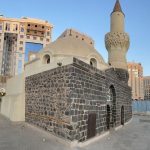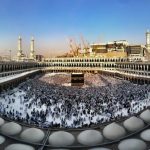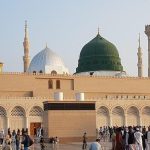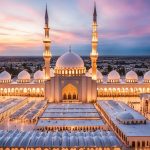Introduction
The Kaaba, also known as Khaana Kaaba, holds a central position in Islam, symbolizing the unity and devotion of Muslims across the globe. As the heart of the sacred sanctuary in Makkah, it has a rich and intricate history marked by numerous reconstructions and alterations, reflecting the cultural, spiritual, and political shifts over time. This blog, brought to you by Umrah International, delves deeply into the history of the Kaaba’s construction, examining its significance from a multifaceted perspective.
In our exploration, we will categorize the history of the Kaaba into two main phases: Before the Advent of Islam and After the Advent of Islam. Each phase presents a unique narrative, filled with religious significance, historical events, and lessons for future generations.
Historical Overview
According to the renowned Islamic scholar Allama Jalal-Ud-Din Suyuti in his work History of Makkah, the Kaaba has been reconstructed ten times throughout its long history. Each reconstruction was prompted by various factors, including natural disasters, structural deterioration, and political changes. Understanding these changes allows us to appreciate the Kaaba’s enduring legacy.
Phases of Construction
- Divine Creation: The Kaaba was first constructed by angels at a location known as “Bay’at Al-Ma’mor,” which holds great significance in Islamic cosmology.
- Hazrat Adam (Peace Be Upon Him): Following its angelic foundation, the Kaaba was built by Hazrat Adam, making it one of the earliest places of worship dedicated to the One God.
- Descendants of Adam: The responsibility of maintaining and rebuilding the Kaaba was passed down to Hazrat Adam’s descendants, ensuring its sanctity was preserved through generations.
- Prophets Ibrahim and Ismail (Peace Be Upon Them): A pivotal moment in the Kaaba’s history occurred when Hazrat Ibrahim and Hazrat Ismail reconstructed it, a fact that is acknowledged in the Qur’an. This act was not only a physical rebuilding but also a reaffirmation of monotheism.
- Amalekites: After the time of the prophets, the Amalekites undertook the rebuilding of the Kaaba, further embedding its significance in the region.
- Tribe of Jarham: The tribe of Jarham also contributed to the Kaaba’s construction, continuing its legacy as a sacred site.
- Quraysh Tribe: Eventually, the Quraysh tribe took over the Kaaba’s reconstruction, which marked a crucial development in its history.
- Participation of Prophet Muhammad (Peace and Blessings Be Upon Him): Notably, the Prophet Muhammad himself participated in the Quraysh reconstruction, demonstrating his deep connection to the Kaaba even before his prophethood.
- Hazrat Abdullah Bin Zubair (RA): Under his caliphate, the Kaaba was rebuilt following the design suggested by the Prophet Muhammad, marking a significant restoration of its original purpose.
- Hajjaj Bin Yusuf: The final major reconstruction occurred under Hajjaj Bin Yusuf during the Umayyad period, which transformed the Kaaba into a more fortified structure.
Historical Interpretations
While Allama Suyuti recounts ten reconstructions, Hazrat Allama Halbi presents a contrasting view, stating that the Kaaba was rebuilt only three significant times:
- Construction by Hazrat Ibrahim (PBUH).
- The Quraysh’s reconstruction, which occurred with a gap of 2735 years from the previous building.
- Construction by Hazrat Abdullah Bin Zubair (RA), occurring 82 years after the Quraysh reconstruction.
This diversity of interpretations underscores the complexity of the Kaaba’s history and its profound significance within Islamic tradition.
Construction of the Kaaba Before Islam
Stages of Kaaba Construction
Imam Ali Bin Abdul Qadir Tabari notes that the Kaaba has been constructed multiple times, yet it is widely accepted that it underwent four primary reconstructions before the advent of Islam.
The First Construction: By Hazrat Ibrahim (PBUH)
When Hazrat Ibrahim constructed the Kaaba, it was built to a height of 9 yards (approximately 4.5 meters). The dimensions of the Kaaba were carefully measured to create a balanced and harmonious structure:
- Length from the East: 32 yards (16 meters)
- Length from the West: 31 yards (15.5 meters)
- Length from the North: 20 yards (10 meters)
- Length from the South: 23 yards (11 meters)
Notably, Hazrat Ibrahim did not cover the Kaaba with a roof, instead opting for two low doors that enhanced its accessibility for worshippers. This design choice reflected the Kaaba’s primary function as a space for devotion and communion with the Divine.
Subsequent Rebuildings: Banu Amalaqa and Banu Jarham
After Hazrat Ibrahim’s era, the Banu Amalaqa and later the Banu Jarham took responsibility for the Kaaba’s reconstruction. Imam Ali Bin Abi Talib (RA) highlights that the wall of the Kaaba weakened over time, leading to these subsequent rebuildings to maintain its structural integrity and sanctity.
- Banu Amalaqa: This tribe undertook the first significant rebuilding after Hazrat Ibrahim, addressing structural weaknesses that had developed over time.
- Banu Jarham: Following the Banu Amalaqa, the Banu Jarham continued the work, ensuring that the Kaaba remained a prominent site of worship and pilgrimage.
Construction by the Quraysh Tribe
The Quraysh undertook another reconstruction after the Banu Jarham. Historical accounts describe an incident where a woman from the Quraysh accidentally ignited the Kaaba with a lantern, prompting the tribe to rebuild it out of fear of divine retribution.
- Modifications: The Quraysh, facing financial limitations, reduced the height of the Hajar Aswad (Black Stone) by 6 yards (3.23 meters) and enclosed it with a wall to prevent direct access during Tawaf (circumambulation).
- Structural Changes: The height of the Kaaba was increased from 9 yards (4.5 meters) to 18 yards (approximately 9 meters). The western gate was closed, and the eastern gate was elevated, creating a more robust and imposing structure.
- Prophet Muhammad’s Role: This reconstruction took place five years before the Prophet Muhammad (PBUH) received his prophethood. During the completion of this phase, a dispute arose among the Quraysh regarding who would place the Black Stone in its position.
The resolution of this dispute demonstrated the Prophet’s leadership qualities. He suggested a collaborative approach, using a cloth to lift the stone, allowing all tribe leaders to participate. This act not only resolved the conflict but also set a precedent for unity among the tribes.
Construction of the Kaaba After Islam
The second phase of the Kaaba’s construction can be categorized into three significant periods, each marked by historical events that shaped its structure and significance.
First Period: Abdullah Bin Zubair (RA)
After the assassination of Yazid bin Muawiya, Abdullah Bin Zubair (RA) emerged as a prominent figure. During his leadership, Makkah faced a siege that severely weakened the Kaaba’s structure.
- Rebuilding Efforts: After the siege ended, Abdullah Bin Zubair (RA) undertook the reconstruction, returning the Kaaba to its original design as established by Hazrat Ibrahim (PBUH). He increased its height significantly, incorporating new architectural features that aligned with the initial divine intentions behind the Kaaba.
- Significance: This phase marked a significant return to the original purpose of the Kaaba as a house of worship, aligning with the divine intentions behind its creation.
Second Period: Hajjaj Bin Yusuf
Following the death of Abdullah Bin Zubair (RA), Hajjaj Bin Yusuf, under the command of Abdul Malik Bin Marwan, sought to assert Umayyad control over Makkah.
- Destructive Measures: Hajjaj launched an attack that resulted in further damage to the Kaaba. In the aftermath, he reconstructed the Kaaba with new designs that aligned with the Umayyad vision.
- Structural Changes: Hajjaj closed the western gate and demolished parts of the northern wall, emphasizing a more fortified design that reflected the political climate of the time. This reconstruction sought to reinforce the Kaaba amidst ongoing political turmoil and civil strife.
Third Period: Sultan Murad Khan
Sultan Murad Khan, a prominent figure in the Ottoman Empire, presided over a period marked by natural calamities that affected the Kaaba.
- Reconstruction Following Flooding: In 1039 AH, heavy rains led to significant flooding in Makkah, resulting in damage to the Kaaba’s structure. Sultan Murad Khan responded by demolishing the weakened walls and undertaking a comprehensive reconstruction.
- Aesthetic Enhancements: This final construction was notable for its architectural beauty, reflecting the artistic traditions of the Ottoman Empire. The Kaaba, as it stands today, retains many features from this period, ensuring its continued relevance as a focal point for Islamic worship.
The Worship in the Kaaba
In ancient times, the Kaaba was dedicated to the god Hubal, featuring an array of 360 idols that symbolized each day of the year (Doak, 2011). During this pre-Islamic era, the Kaaba was often referred to in feminine terms, as Wynbrandt (2010) notes. Ritual practices involved men circumambulating the Kaaba completely naked, while women were partially clothed. These actions were part of fertility rites believed to enhance the community’s fertility rates. Annually, the Kaaba transformed into a shrine for Allah, attracting a diverse congregation of worshippers from far and wide—both Muslims and non-Muslims—who encircled the Kaaba, emphasizing that Allah was indeed the God of all people.
The Colored Stones of the Kaaba
According to McCrudden (2010), many structures resembling the Kaaba existed in pre-Islamic Arabia, but the Kaaba in Al-Masjid was uniquely constructed from stone. Other so-called “Kaabas” were made from various materials, such as red stones in the region of Ghaiman, associated with a god of South Arabia, and white stones found in Tabala (Campo, 2012). During the era preceding Islam, people often linked divinity to natural elements like mountains, trees, and stones. The Kaaba’s stone construction established it as the most sacred site, believed by many to be the center of the universe, with the gateway to heaven positioned directly above it (Wynbrandt, 2010). The black stones embedded in the Kaaba’s walls symbolized a profound connection between heaven and earth.
Doak (2011) points out that around 400 years before the birth of Muhammad, Amr bin Lahyo placed an idol atop the Kaaba, which served as the principal deity for the Quraysh tribe. This idol, crafted from red agate and adorned with a golden hand, was later moved inside the Kaaba. To maintain the sanctity of the site, Amr bin Lahyo declared the Kaaba a sanctuary, prohibiting violence within a thirty-kilometer radius (McCrudden, 2010). Beyond its role as a place of prayer, the area surrounding the Kaaba also flourished as a commercial hub, with people coming from various regions to trade goods such as textiles and livestock.
McCrudden (2010) notes that the Kaaba existed long before the advent of Christianity, serving as a significant site in the region. Makkah was recognized for its rich spice trade, although some skeptics claimed it functioned merely as a resting point for traders en route to other areas of Arabia (Campo, 2012). During these stopovers, traders exchanged commodities like cloth, grains, and camels with the local inhabitants of Makkah.
The Initial Construction
Around 2100 BC, Allah commanded Prophet Abraham to construct the Kaaba at the banks of the Zamzam River (Doak, 2011). Shortly after the construction was completed, an angel presented Abraham with a black stone, believed to have been collected from the Qubays region (Wynbrandt, 2010). Originally white, this stone turned black as a result of absorbing the sins of humanity (McCrudden, 2010). Today, the black stone remains the only part of the original Kaaba, symbolizing its sanctity.
The Revelation
After placing the black stone in a corner of the Kaaba, Allah instructed Abraham to travel the world and proclaim the word of God (Campo, 2012). He shared this revelation with other prophets, urging people to journey to the Kaaba and worship Allah. Many pilgrims traveled from distant lands on camels, donkeys, and on foot to pay homage. Muslims hold that the Kaaba is over a thousand years older than the Jerusalem Temple, positioning it as the oldest place of worship (McCrudden, 2010).
The Conflict and Rededication of the Kaaba
Following the construction of the Kaaba, ongoing conflicts arose as Muslims sought to defend themselves against Meccan aggressors. In 628 AD, a treaty was established, but it was violated two years later by the Quraysh tribe, who attacked the Bedouin Khuza’a tribe (McCrudden, 2010). In the ensuing battle, the Muslims emerged victorious, resulting in significant devastation throughout the city of Makkah. After the conflict, Prophet Muhammad, accompanied by his followers, led a procession to the Kaaba (Campo, 2012). However, he refrained from entering the Kaaba initially, citing the presence of idols within it. According to Doak (2011), Abu Sufyan and Mughira were dispatched to remove the idols from inside the Kaaba.
Among these idols were representations of the prophets Abraham and Ishmael, depicted holding arrows (Wynbrandt, 2010). After their removal, Prophet Muhammad proclaimed that Allah would destroy these idols because they represented disbelief. Subsequently, he entered the Kaaba, circumambulating it while proclaiming “Allahu Akbar,” and then exited without offering any formal prayers (Doak, 2011). This event marked the rededication of the Kaaba, establishing it as a central site of worship. It became the focal point for the annual pilgrimage, which over time evolved into a fundamental rite for Muslims (Campo, 2012). It was thereafter mandated that every Muslim must visit the Kaaba at least once during their lifetime, or engage in pilgrimage to other sacred sites in Makkah.
The Architecture of the Kaaba
The Kaaba is a cubical structure constructed from granite blocks sourced from nearby hills (Campo, 2012). Its foundation is made of marble stones, while the interior floor boasts an elegant limestone surface (McCrudden, 2010). The floors are adorned with white marble tiles, and the walls are draped in a rich green cloth embellished with gold embroidery. Inside the Kaaba, three pillars support the structure, and an altar is positioned between them (Doak, 2011). Lamps hang gracefully from the ceiling, and the entrance door is crafted from gold. The interior of the Kaaba can accommodate approximately fifty people at a time (McCrudden, 2010).
The Features of the Kaaba
Prominently, the Kaaba houses the Black Stone, located at its eastern corner (Wynbrandt, 2010). Each of the four corners—northern, eastern, western, and southern—aligns with cardinal directions. The foundation of the Kaaba is elevated, resulting in its doors being positioned higher than those of adjacent buildings, accessed via a wooden staircase. A gold spout, known as the Meezab, allows rainwater to flow away from the structure. This spout was added in 1962 following damage from floods (McCrudden, 2010). To safeguard the foundation from groundwater, a protective gutter encircles the Kaaba.
Additionally, the Kaaba features the Hateem, a semi-circular area with walls that are thicker and lower than the main structure (McCrudden, 2010). The Hateem walls stand approximately one meter high and one meter wide (Doak, 2011) and are constructed from marble. It is traditionally believed that the grave of Prophet Ismail lies within this area. Nearby, Al-Multazam, the wall closest to the entrance, serves as a sacred space for supplication, where many Muslims, particularly pilgrims, often touch during their prayers (Campo, 2012).
The Maintenance of the Kaaba
Twice a year, the Kaaba is opened for a ceremonial cleaning (McCrudden, 2010). The first cleaning occurs about thirty days prior to Ramadan, followed by another in preparation for Hajj. During these times, the Kaaba is typically closed, with the keys securely held by the Bani tribe (Doak, 2011). The cleaning process involves the use of rose water, and if this is unavailable, water is sourced from the nearby Zamzam well, as Muslims regard its water as sacred (Campo, 2012; Wynbrandt, 2010)
The Kaaba in Islamic Tradition
The Kaaba is not merely a physical structure; it holds deep spiritual significance for Muslims around the world. It is the Qibla, the direction toward which all Muslims pray, symbolizing unity in worship.
Spiritual Significance
- Symbol of Monotheism: The Kaaba is a symbol of the oneness of God and serves as a reminder of the monotheistic teachings of Islam. Its reconstruction by prophets is a testament to the importance of worshiping the One Creator.
- Destination for Pilgrimage: Each year, millions of Muslims travel to Makkah to perform Hajj and Umrah, making the Kaaba the most visited religious site in the world. This pilgrimage is a profound act of worship that embodies submission, humility, and devotion to Allah.
- Connection to Prophetic Tradition: The Kaaba is deeply intertwined with the life of the Prophet Muhammad (PBUH). His actions and teachings regarding the Kaaba have set a precedent for future generations, emphasizing its importance in Islamic practice.
The Kaaba in Contemporary Times
The Kaaba continues to serve as a focal point for Muslims worldwide. Modern technology and infrastructure have enhanced the pilgrimage experience, allowing millions to visit this sacred site each year. The Kaaba remains a symbol of unity, love, and faith, drawing individuals from diverse backgrounds to worship in harmony.
- Technological Innovations: With advancements in technology, facilities surrounding the Kaaba have improved significantly. Modern amenities ensure a comfortable pilgrimage experience, allowing more individuals to fulfill their religious obligations.
- Cultural Exchange: The Kaaba serves as a meeting point for cultures and traditions from around the world, fostering understanding and solidarity among Muslims. This exchange enriches the overall experience of pilgrimage, allowing for shared stories and spiritual insights.
- Global Unity: The Kaaba symbolizes the unity of the Muslim Ummah. Regardless of nationality, ethnicity, or socio-economic status, Muslims gather at the Kaaba with a shared purpose
Conclusion
The history of the Khaana Kaaba is a testament to its enduring significance in the Islamic tradition. From its divine origins to the various reconstructions over centuries, each phase highlights the Kaaba’s pivotal role in uniting Muslims around the world. As a sacred space that encapsulates the essence of worship and devotion, it continues to inspire millions.
The Kaaba’s history is a testament to its enduring significance in the spiritual landscape of Islam. It has evolved from a site of diverse pre-Islamic worship into a singular focal point of monotheistic faith, drawing millions of believers who recognize it as the house of Allah. Its architectural integrity, rich history, and the profound symbolism of its stones continue to inspire and unite the global Muslim community today.
As you plan your journey to experience the blessings of Umrah, Umrah International is here to assist you in making your pilgrimage seamless and spiritually enriching. May Allah grant us all the opportunity to visit this blessed house, which has captured the hearts of millions and serves as a spiritual beacon for all of humanity worshiping Allah and submitting to His will.

